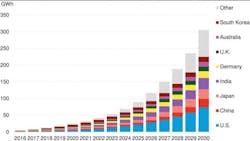$2M Renewable Microgrid in Alberta Wins Grant…Energy Storage to Reach $130B…South Australia’s Battery Milestone
Medicine Hat College awarded $215,000 grant for renewable microgrid
A college in Alberta, Canada has won a $215,000 grant to apply toward a $2 million renewable microgrid in planning on the campus.
Medicine Hat College won the money from Alberta’s Community and Regional Economic Support (CARES) program. The microgrid grant is part of a $4 million CARES distribution to various local economic development efforts.
The college intends to install a solar parking lot canopy and EV charging station as part of the microgrid.
Called the Community Renewable Energy Microgrid Demonstration Project (CREMDP), the installation will act as an equipment testing site for innovators. It also will serve as a learning lab for students, a demonstration project for the province, and a component of the campus sustainability strategy.
The microgrid is being built under an Alberta program that allows land owners, municipalities, and organizations to manage power projects of up to 5 MW, according to the college’s comprehensive institutional plan for 2017-2020.
Bloomberg New Energy Finance forecast $103 billion energy storage investment
Talk about impressive growth. The global energy storage market will double six times between 2016 and 2030, reaching 125 GW/305 GWh, according to a new report by Bloomberg New Energy Finance.
The report forecasts that $103 billion will be invested in energy storage over the 24 years studied. The investment will be spread roughly equally across the Americas, Asia Pacific and Europe, Middle East and Africa regions, according to BNEF.
BNEF compares the energy storage market’s rise to that of solar between 2000 to 2015. During that period, the share of photovoltaics as a percentage of total generation doubled seven times.
For energy storage, the market leaders will U.S., China, Japan, India, Germany, U.K., Australia and South Korea, together accounting for 70 percent of installed capacity, according to the report.
BNEF says that both utility-scale and behind-the-meter energy storage will be a crucial source of flexibility, necessary for integrating more and more renewable energy into electricity systems.
“The industry has just begun. With so much investment going into battery technology, falling costs and with significant addition of wind and solar capacity in all markets, energy storage will play a crucial part in the energy transformation,” said BNEF energy storage analyst Yayoi Sekine, lead author of the report.
Source: Bloomberg New Energy Finance
South Australia completes installation of “world’s largest” battery
South Australia has finished installing what Premier Jay Weatherill calls the “world’s largest lithium ion battery” and will begin using it for back-up power in the summer.
Connected to Neoen’s Hornsdale windfarm near Jamestown, the battery will enter regulatory testing in the coming days, according to a November 24 announcement by South Australia’s government.
In July, French renewable energy company Neoen and US sustainable energy company Tesla won the contract to deliver the project in a competitive bid.
“The world’s largest lithium ion battery will be an important part of our energy mix, and it sends the clearest message that South Australia will be a leader renewable energy with battery storage,” said Weatherill.
Follow news about renewable microgrid projects on Twitter @MicrogridNews.
About the Author
Elisa Wood
Editor-in-Chief
Elisa Wood is the editor and founder of EnergyChangemakers.com. She is co-founder and former editor of Microgrid Knowledge.
